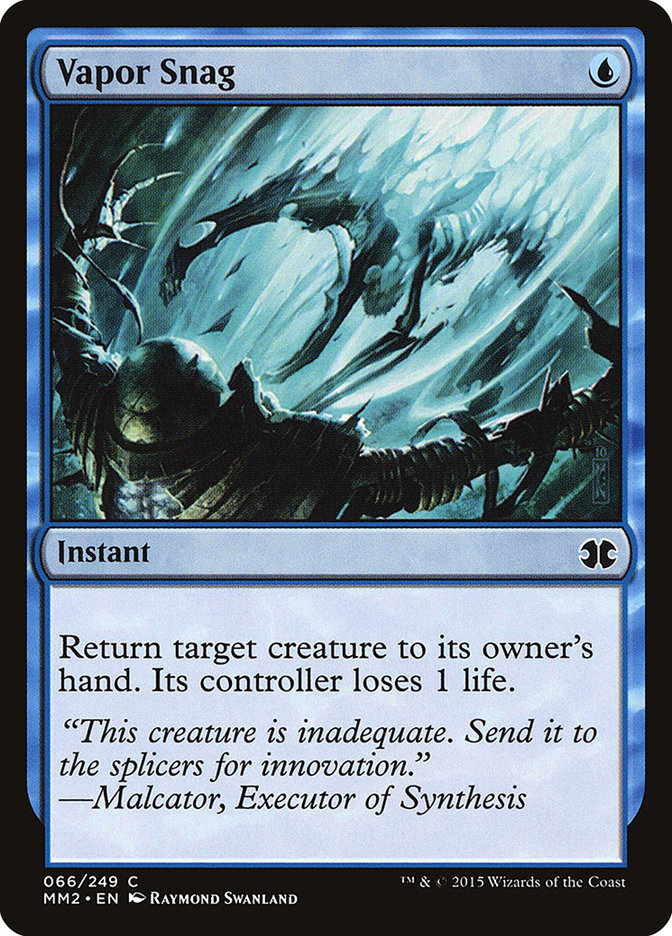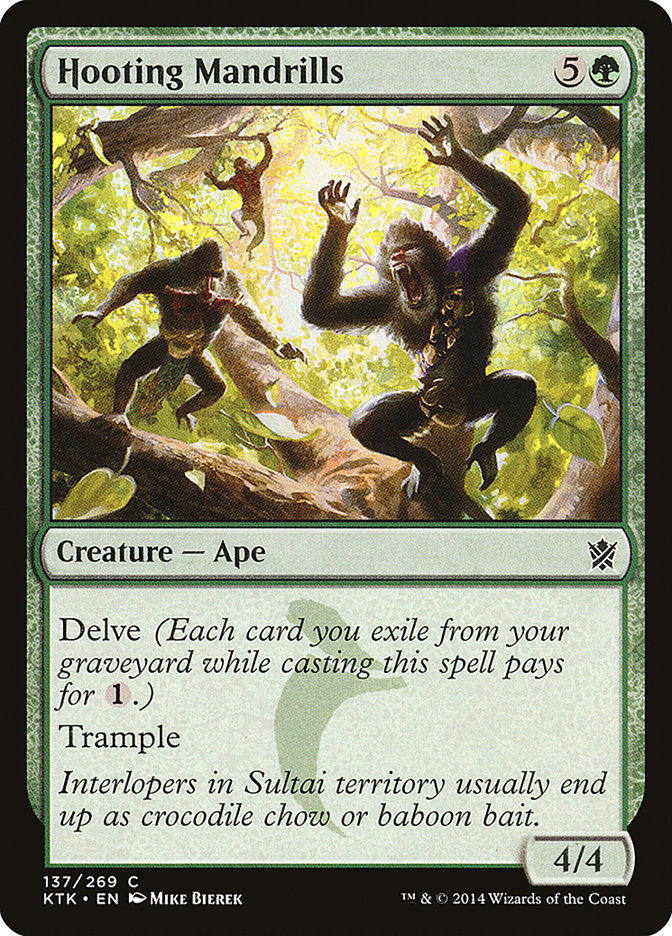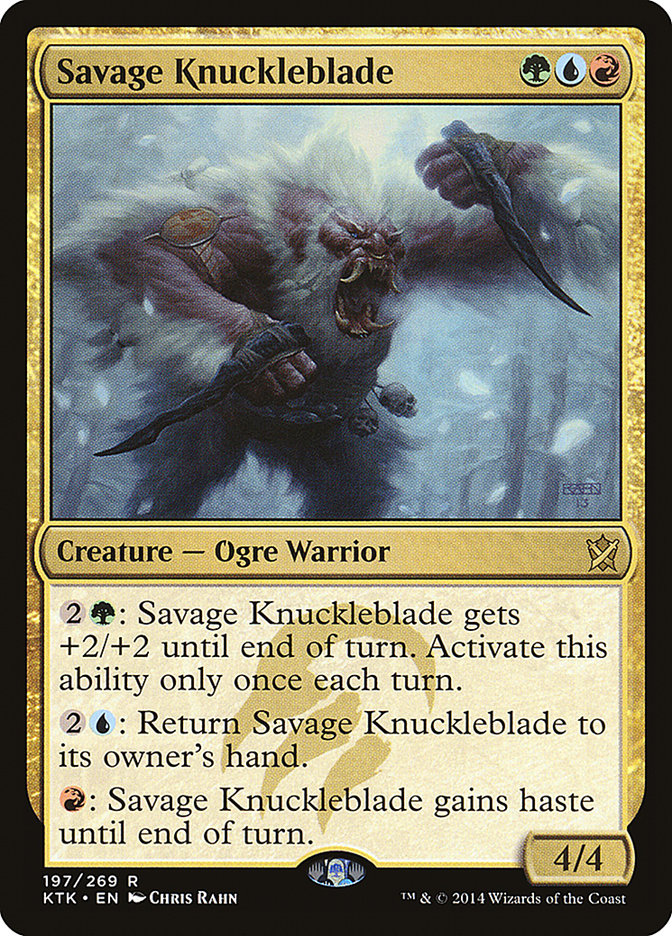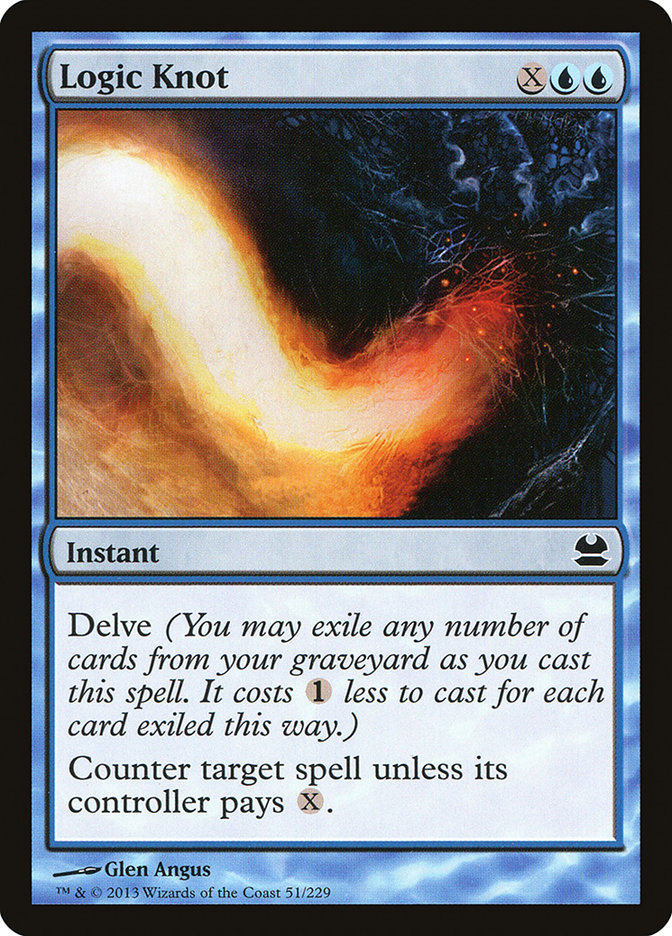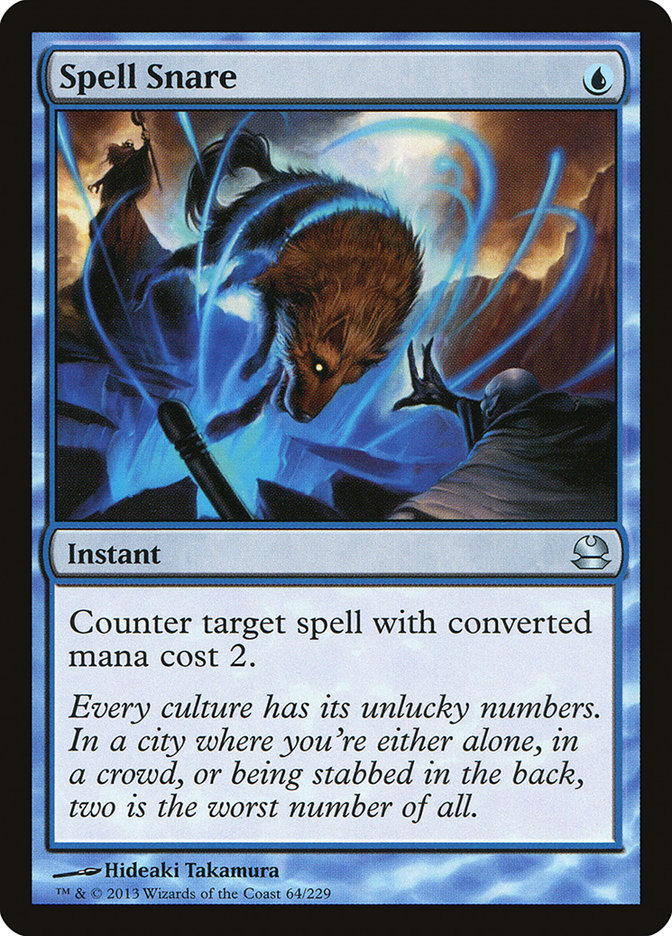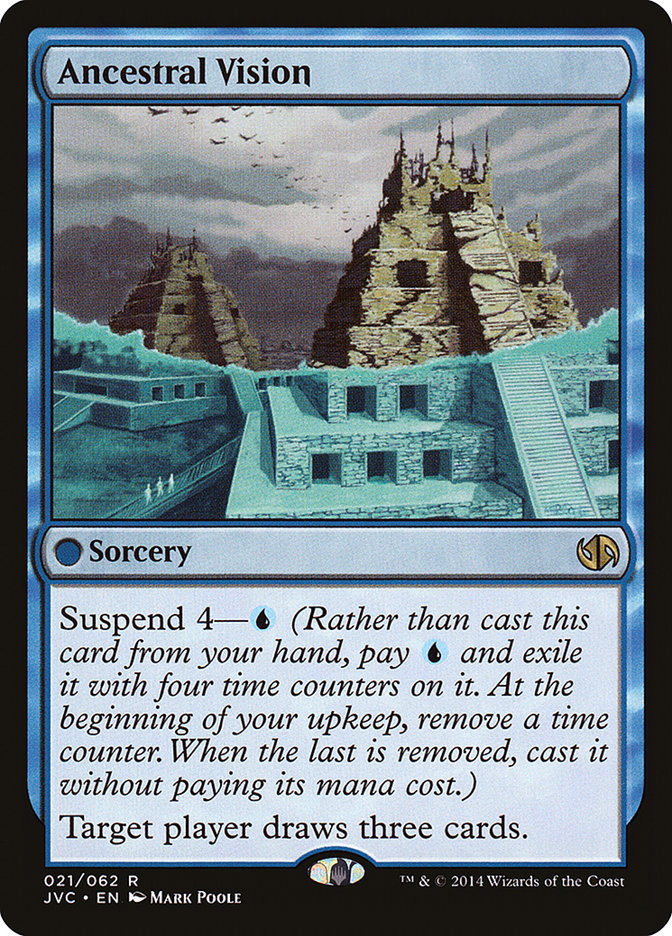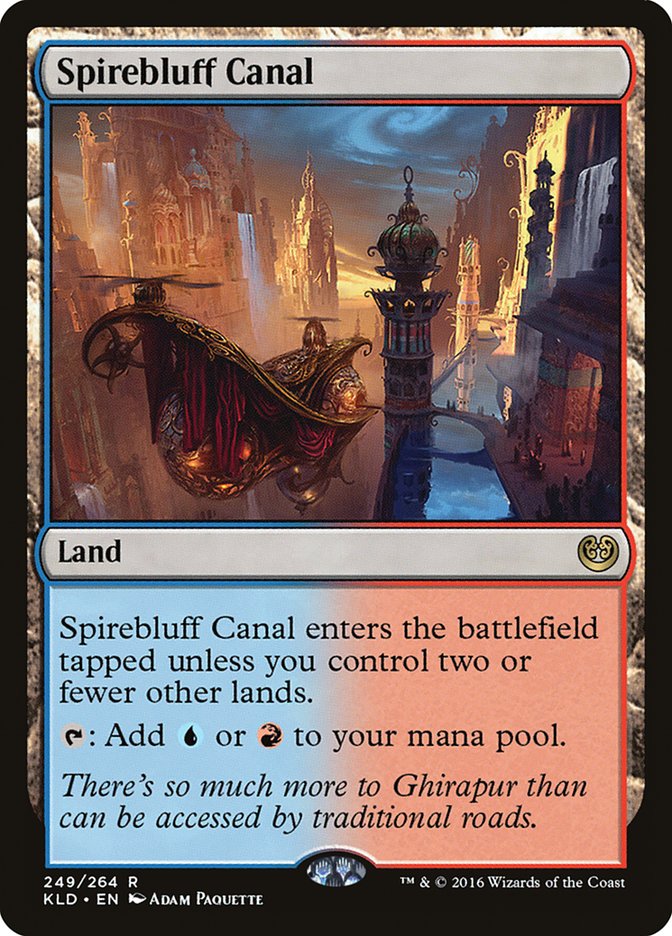Temur. A color combination truly close to my heart. So dear, in fact, that
I have an entire box dedicated to building all sorts of variations in the
Modern format. But why? Why is Temur the color combination I’ve hooked my
wagon to?
The short answer is that I really love tempo decks. Ever
since Delver of Secrets was printed in Standard and I got to play it
alongside Vapor Snag, I haven’t quite felt the same playing with any other
archetype. I like putting a big clock on my opponent while disrupting their
early plays with counterspells. I like bouncing creatures to push through
exact lethal damage. I like Snapcaster Mage in a shell that makes the body
relevant.
The long answer is the rest of the article, along with how I would build a
Temur deck in the current Modern metagame.
Let’s dig in.
No, this isn’t a card in my “Temur” deck. I wouldn’t catfish you like that.
Death’s Shadow is currently the deck to beat, and I need to make sure that
my Temur deck can actually handle something so monstrously powerful.
Creatures (13)
Planeswalkers (2)
Lands (18)
Spells (27)

Temur is infamously bad at killing big creatures from the other side of the
table. We don’t get to play Fatal Push, and I’m often resigned to using
stuff like Dismember or Roast to knock down Tarmogoyf or Tasigur, the
Golden Fang.
But Death’s Shadow is bigger than anything we could play in the hopes to
kill it. So instead, we’re just going to bounce it I guess.
Now, Death’s Shadow is currently the top dog in the format, even if it
didn’t win back-to-back tournaments. It has been the talk of the
professional circuit in the last few weeks, and the trickle down that
created leaves us with one of the most popular decks we’ve ever seen in the
Modern format. I wouldn’t be surprised to play against it four or five
times in a fifteen round event, though I do admit that seems a bit steep.
The real question is this: Can our deck beat Death’s Shadow? I don’t know,
but I think Delver of Secrets (in general) is favored against Death’s
Shadow.
As I talked about before in the early iterations of Delver of Secrets in
Standard, Vapor Snag was a big part of why that deck was successful. While
Delver of Secrets could flip early and apply a lot of pressure, blue wasn’t
exactly well-equipped to handle the large creatures that could fight back.
And neither was the white splash, for that matter. Instead, we had to go
the route of tempo as opposed to hard removal. Enter Vapor Snag.
The Illusion of Card Disadvantage
While Vapor Snag is technically card disadvantage, it often plays the role
of hard removal because you could leverage that tempo play by making the
card irrelevant. Most creatures in Magic have a short shelf life, meaning
that if they don’t get in some chip damage early then they aren’t really
doing what they’re designed to do. Obviously, this theory gets broken up
when the format is full of “value” creatures that gain some minor advantage
upon entering the battlefield, but that isn’t really where we’re at in
Modern at the moment. In fact, I’d say that Modern is actually just a
battleground of the format’s cheapest threats. Whoever can cast the most
threats in the early turns of the game is usually going to be at a
significant advantage. And, as you have probably figured out by now, cheap
creatures don’t usually come with attached value.
With that said, Vapor Snag is definitely worse when the format is full of
cheap creatures. Ideally, you want Vapor Snag to target a two-, three-, and
four-drop creature that doesn’t have a huge effect when it enters the
battlefield. For each mana you’re trading up, you’re effectively gaining
that much mana in the tradeoff. What you’re losing in a card, you’re
trading for in mana (and the one-point life loss). If you’re unable to
leverage that extra mana, then Vapor Snag doesn’t seem very good. I’m sure
I’ve cast my fair share of Vapor Snags without a creature of my own on the
battlefield, and those are certainly hard times; but the effect can be a
powerful one that will often close out games when cast in the right spots
and against the right creatures.
Alongside Lightning Bolt and Vapor Snag, there’s a good chance that a
single Snapcaster Mage can kill an unwary Death’s Shadow opponent. Bouncing
multiple creatures, dealing them huge chunks of damage; this is the easy
way to steal games from Death’s Shadow. They usually deal themselves
upwards of twelve damage in a single game, which doesn’t leave you with too
much work to do.
Now, Snapcaster Mage also plays a vital role outside of the Death’s Shadow
matchup. Since most of your opponents won’t be Death’s Shadow, we do need
to play some cards that match up well against the rest of the field. And
what better card than Snapcaster Mage? It doubles up as a second copy of
your best card with a 2/1 body attached. I don’t think I need to actually
explain why that’s a good thing, but
Split Second previewed it earlier this week
, so I’m in the mood to celebrate him.
What Snapcaster Mage does in this deck is unique compared to almost every
other Snapcaster Mage deck in the format. Since we’re putting pressure on
the opponent with early creatures like Tarmogoyf or Delver of Secrets, the
body of Snapcaster Mage can end up mattering a lot. I can’t tell you how
many games I’ve won in Modern when the only creature I cast was Snapcaster
Mage.
Spoiler: It’s a lot.
Leveraging Vapor Snag to protect Snapcaster Mage is also a fine line to
take with a deck like Temur. In some cases, we have to get scrappy to get
the most out of our cards. We aren’t playing a ton of powerful cards that
can win the game on their own. For the most part, our entire deck revolves
around every card doing a specific job. When every card does that job
correctly, we are usually at a distinct advantage.
Bringing Temur Back
Drawing too many creatures against aggressive decks or too many removal
spells against non-creature decks will lead to some lopsided games. That’s
why we need a well-constructed maindeck to give us balance, as well as a
good sideboard to alleviate some of those issues. Now, the best part of
playing Temur, as opposed to black or white, is that most of our removal is
rarely going to be dead. Lightning Bolt can go to the dome, where I point
it roughly 30 percent of the time anyway, and Vapor Snag can protect our
creatures from their removal. Aside from Vapor Snag and Lightning Bolt, we
have a lot of options on what else we could play.

This is the short list of maindeck-able removal spells. In the current
metagame, my gut is telling me that Dismember is pretty bad. And, honestly,
it doesn’t seem like it pairs all that nicely with Vapor Snag. If we wanted
to kill every creature our opponent played, we would likely lean toward a
different color combination. Fatal Push and Abrupt Decay are pretty good
removal spells, to be honest. So, with that in mind, I think we want most
of our removal to be damage-based so that no draw is truly dead.
I’ve always had a soft spot for Forked Bolt anyway.
As for the threats:


This is basically every creature I’ve ever put in a Temur Delver maindeck.
Choosing between these is like asking me to choose my favorite cat. Sure,
two of them are clearly better than the third, but that doesn’t mean I
don’t love that third cat just as much as the other two. I just don’t want
to play with it as much. And to be frank, he’s kind of a jerk.

All jokes aside, any creature that dies to Tarfire is likely too small to
play at the moment. On top of that, losing Gitaxian Probe makes Young
Pyromancer nearly unplayable as well. So, the real question is, do we want
to get fancy and play a few one-ofs alongside Traverse the Ulvenwald and
(probably) Mishra’s Bauble? Or is it safer to just play a normal Delver
deck and promote redundancy with the threats to make discard effects less
devastating? My gut tells me that the second option is likely best, as
Delver of Secrets doesn’t play well with cantrip effects like Mishra’s
Bauble, and I feel like turning on delirium might be more difficult than I
want it to be.
So, my vote is Delver of Secrets, Tarmogoyf, Snapcaster Mage, and Hooting
Mandrills. That doesn’t mean we can’t play ol’ Savage Knuckleblade in the
sideboard. Having a few threats in the sideboard gives us a bit more punch
against opponents packing a lot of removal, and Savage Knuckleblade is a
pretty sweet one to bring in against slower opponents.
But if we want to play Hooting Mandrills, that means we need to build our
deck in such a way that we can play it cheaply and consistently.
And that likely means just packing the deck with Thought Scour, much in the
way Grixis decks ramp into Tasigur, the Golden Fang. While Thought Scour
isn’t anything to write home about, enabling delve is a big deal. Plus, you
have the backdoor option of getting rid of the top card of your deck if
Delver of Secrets reveals a stinker.
Filling the Deck Out
Aside from removal, we need other forms of disruption. Here’s the short
list of cards I’m trying to fit into the deck.

At the moment, Modern seems to be too full of cheap cards for Remand to
shine. In a format featuring a ton of blue decks, Remand is significantly
better because it allows you to win counterspell battles in some unique
ways. However, when the average mana cost of cards being played is
somewhere around 1.3, Remand is not where you want to be. In times past,
that’s also been a major reason for me to not play Temur in any form.
Remand is usually one of the best cards in the deck, but that just can’t be
true when everything is so cheap!
So that leads me to believe that Mana Leak is the go-to counterspell for
the mid-game. While Mana Leak can become mediocre in a hurry, you can
usually put them under enough pressure to force their hand, making Mana
Leak a functional copy of Counterspell. There are some arguments to playing
Logic Knot instead, but I’ve found that I very much enjoy searching up
basic lands with this deck, which makes Logic Knot a bit worse than I would
like.
The one-mana counterspells are a little tougher to figure out. I kind of
want Spell Snare to help defend against opposing Tarmogoyf decks, but many
of those don’t play two-drops other than Tarmogoyf itself. Like I said
before, we’re probably going to lean pretty hard on Vapor Snag to “deal”
with the bigger threats that we face. Spell Pierce, like Mana Leak, can
become worthless as the game drags on, but again, we are usually able to
put enough pressure on the opponent to make Spell Pierce very good in the
early turns of the game. Plus, Modern is chock full of combo decks at the
moment, making Spell Pierce seem pretty reasonable. The beauty about a deck
like Temur Delver is that you have cards that are so similar, yet attack
fundamentally different things, that you have to read the format for your
support spells to do their job. If the format starts to lean toward
two-drops instead of one-drops, then Spell Snare gets a lot better.
I’ve maindecked Dispel a few times in my life, but I don’t know if right
now is the best time to be doing it. Overloading on Spell Pierce is also a
little dangerous, so we have the option to play two copies of Spell Pierce,
and either one copy of Spell Snare or Dispel in the maindeck, supplemented
by additional copies in the sideboard. My gut says Dispel for now.
Cryptic Command is a strange card that I usually like to play one or two
copies of, but I just don’t know if this is the right time to be doing
that. Four mana sure is a whole lot in Modern, and I’m afraid it just won’t
be good enough. With that said, there are a lot of advantages to playing a
single copy of a powerful late-game spell like Cryptic Command. With
Snapcaster Mage, we effectively have an additional copy at our disposal if
the game goes long enough, and I’ve never really been unhappy to draw
exactly one copy of Cryptic Command, so maybe one is just the right answer.
As for cantrip effects:
We need some ways to smooth out our draws. As I’ve already said, we need to
play at least three copies of Thought Scour to make Hooting Mandrills a
reliable early play, but Serum Visions is by far the best early draw spell
in Modern. Making sure your one-land hands don’t fumble is a huge deal when
you’re planning on playing twenty or fewer lands, and giving your
Snapcaster Mage something to proactive to do on the third turn is hugely
important on a stalled board.
Ancestral Vision is not where I want to be right now. I’ve seen far too
many people die with it sitting on one suspend counter. It could be a
potential option out of the sideboard to help alleviate some of the
pressure put on us by hand disruption, but it isn’t like drawing three
cards is going to save you from a Tarmogoyf that you can’t kill.
The Manabase
I’ve said for a long time that I wanted access to a “Seachrome Coast” for
Izzet colors. In fact, I went so far as to say that Spirebluff Canal would
likely be the best card in Modern. I might have been wrong on that one, but
the lands from Kaladesh are pretty spectacular for what we’re
trying to do in the Modern format. Cheap spells without taking damage is a
boon for decks like Delver.
But we also have to make sure we don’t overload on Spirebluff Canal and
friends, as it is important to balance fetchlands to enable Hooting
Mandrills, and basic lands to play around Blood Moon/taking too much
damage.
After thinking through all of the card choices, I’m a little short on
cards. This is the start to the list.
Creatures (15)
Spells (22)

Remember what I said about balance? Well, at this juncture, I’d love to
just jam some Gitaxian Probes into the list and call it a day.
Unfortunately, that is an impossibility, so we have to figure out what’s
missing. Right now we are looking at eight removal spells. I could concede
that we want something like one Electrolyze, and maybe even a Dismember to
help fill things out. We could just jam a fourth copy of Vapor Snag or Mana
Leak in there too. Another creature might be fine as well, but I don’t want
to play too many. Delver of Secrets needs just the right number of hits to
make it worthwhile, and that usually means playing fifteen or sixteen
creatures at the most.
When it comes time to actually play in the tournament, I’ll take out my
Temur box and fill in the blanks. For now, I’ll put up some placeholders
for you, but feel free to change things around. Like I’ve said time and
time again, building decks like Temur Delver, or anything from The Temur
Box, takes some finesse. You have to feel it out.
Creatures (15)
Lands (19)
Spells (26)

So there you have it. An exercise in building a Temur Box deck. Of course,
the experience is much more enjoyable when you’re doing it at midnight
right before a big tournament, but this works too. Don’t be afraid to build
your own Temur Box, for whatever color combination or archetype you’re most
comfortable with. Seriously, give it a try sometime. I’ve never had more
fun playing Magic than building a “cards I own” deck.



